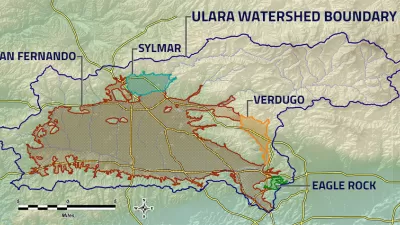The UAE has created a storage facility under the desert that can provide up to 100 million liters per day in the event of an emergency.

From the 2018 International Water Summit in Abu Dhabi, Akshat Rathi reports that underneath the desert, far from the desalination plants, there is now a very prudent reserve of 26 billion liters of water available for the United Arab Emirates in a crisis. Like many of the projects funded by the massive oil wealth of the UAE, it is an impressive feat of engineering.
“The desalinated water is transported through large pipes (about 1 meter in diameter), which had to be pieced together in the desert through high-precision welding to make them leak-proof for at least 50 years. The water is then dumped about 80 meters underground through perforated pipes, where it seeps deeper into the aquifer. There are about 300 wells to recharge, recover, and observe the aquifer’s water.”
Despite its arid climate, the UAE has one of the highest rates of per capita water consumption in the world; as a result of its arid climate, it is particularly vulnerable to climate change. It was the potential impact of climate change that inspired the reserve.
The project is likely to draw a great deal of interest, but the expense makes it of limited use to the rest of the world. Even in the United States, officials tend to balk at just the cost of desalination, let alone the cost of moving and storing the water underground. And the U.S. is in better financial shape than many of the world’s more arid nations.
“For most others facing water scarcity,” Rathi writes, “there’s no oil money to help.”
FULL STORY: The UAE has built the world’s largest desalinated water reserve—under a desert

Alabama: Trump Terminates Settlements for Black Communities Harmed By Raw Sewage
Trump deemed the landmark civil rights agreement “illegal DEI and environmental justice policy.”

Planetizen Federal Action Tracker
A weekly monitor of how Trump’s orders and actions are impacting planners and planning in America.

How Atlanta Built 7,000 Housing Units in 3 Years
The city’s comprehensive, neighborhood-focused housing strategy focuses on identifying properties and land that can be repurposed for housing and encouraging development in underserved neighborhoods.

In Both Crashes and Crime, Public Transportation is Far Safer than Driving
Contrary to popular assumptions, public transportation has far lower crash and crime rates than automobile travel. For safer communities, improve and encourage transit travel.

Report: Zoning Reforms Should Complement Nashville’s Ambitious Transit Plan
Without reform, restrictive zoning codes will limit the impact of the city’s planned transit expansion and could exclude some of the residents who depend on transit the most.

Judge Orders Release of Frozen IRA, IIJA Funding
The decision is a victory for environmental groups who charged that freezing funds for critical infrastructure and disaster response programs caused “real and irreparable harm” to communities.
Urban Design for Planners 1: Software Tools
This six-course series explores essential urban design concepts using open source software and equips planners with the tools they need to participate fully in the urban design process.
Planning for Universal Design
Learn the tools for implementing Universal Design in planning regulations.
Jessamine County Fiscal Court
Caltrans
Institute for Housing and Urban Development Studies (IHS)
City of Grandview
Harvard GSD Executive Education
Toledo-Lucas County Plan Commissions
Salt Lake City
NYU Wagner Graduate School of Public Service





























